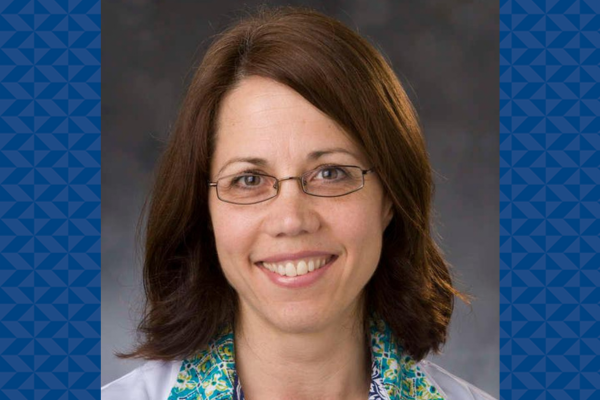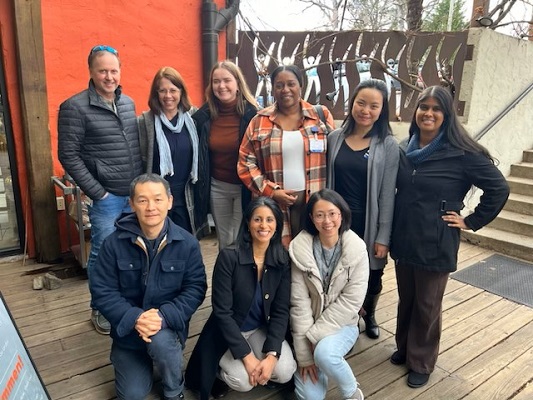
Dr. Stefanie Sarantopoulos grew up in the Connecticut textile mill town of Danielson, where her Greek immigrant grandparents settled. When she was 12, her parents moved the family across the country to open a restaurant in rural Arizona—the Olympic Pizzarama—where Dr. Sarantopoulos discovered how much she loved people—and their stories.
But it was not until years later, when working on her PhD dissertation at Boston University, that she realized the impact she could have on some of these stories: on the lives of others.
Dr. Sarantopoulos, a professor in the division of Hematologic Malignancies and Cellular Therapy (HMCT), a professor in the department of Integrative Immunobiology and co-leader of the Immuno-Oncology Program at the Duke Cancer Institute (DCI), has dedicated the last 15 years to developing safer, curative immunotherapy for patients with hematological malignancies, becoming internationally known for her work.
An Affinity for Cancer Patients
Dr. Sarantopoulos’s own story begins in high school when she developed a sudden thirst for scientific inquiry after her biology teacher refused to teach evolution because he ‘didn’t believe in it.‘ “As a teenager this made me want to read more about science, not less,” she said. “I developed a nerdy way of rebelling, I guess.”
In medical school, she developed an affinity for cancer patients. “But it drove me a bit mad thinking about implementing agents without understanding more,” said Dr. Sarantopoulos, whose Duke lab studies human B cell biology after allogeneic stem cell transplantation. So, she focused on chronic Graft Versus Host Disease (GVHD), after finding it, “unacceptable to cure someone of their cancer and given them a debilitating, life-threatening disease that we knew so little about.”
In the world of rare blood, bone marrow, lymph cancers and diseases treated by the HMCT team, multi-disciplinary teamwork is crucial in order to see patients regularly, to prepare cell products and to care for immune toxic side effects. It is a kind of patient care, Sarantopoulos noted, that is closely linked to the science.

“My lab and many others in the division are full of very talented and hard-working people who don’t get the credit they deserve, but they really are the ones digging deep into those questions that end up helping our patients,” she added, crediting family and mentors for much of her own success.
In January, Dr. Sarantopoulos assumed the role of HMCT division chief. Bringing scientists and clinicians together, she noted, to come up with the next best curative treatments for patients at the Duke Blood Cancer Center (BCC) is what drew her to the division chief role.
“We have the best and brightest lab researchers and the most expert, caring staff, doctors, nurses and advanced practitioners at Duke. Having spent a quarter of a century studying and trying to capitalize on what we have learned about the immune system, I can’t imagine a better time to take this job,” she said. “Cell therapy and immunotherapies are rapidly advancing and it’s a privilege to work in this moment with such a great team.”
Patient-First Culture
The division of HMCT’s has a patient-first culture of innovation that was strongly promoted by Dr. Nelson Chao, former division chief. Dr. Sarantopoulos has a similar vision and plans for moving the division forward.
“Nelson Chao promoted this culture with a terrific sense of hope and trust, hope that science will lead us to answers that will help people,” she explained. “And trust in one another to do the very best we can do every single day we come in to take care of some of the sickest people in the health system. My vision is to bring exceptional, cutting-edge care to our patients at the BCC.”
Dr. Sarantopoulos also wanted to take on the division chief role, in part, to help improve the health outcomes of our communities. One way to do that, she said, is through opportunity and education.
“At a tertiary-care center like Duke, we teach other doctors what we have the privilege to specialize in and become super expert at, and those doctors take care of more patients. Nothing is more important than spotting talent and enabling a person’s career path, she said. It’s been a joy at this stage of my career seeing undergraduate, post-baccalaureate students (especially from nearby HBCUs) on my watch get into medical and MD/PhD programs. Diversifying physician-scientist work force will lead to scientific advances and to improved outcomes for our communities.”
Apprenticeship teaching is the means by which high quality medicine is carried on, along with HMCT research groups at Duke. Studies in allogeneic stem cell transplant over the last half century, for example, have led to the advent of other exciting cell therapies, and will continue to teach a great deal about human immunology and immune-therapy development, she added.